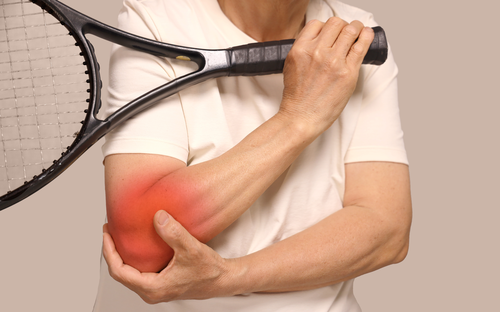Elbow pain can be frustrating, especially when it begins to interfere with daily activities or sports you enjoy. Two common sources of elbow discomfort are golfer’s elbow and tennis elbow—conditions that, while similar, affect different parts of the joint. Whether you’re an athlete or someone who engages in repetitive arm motions, it’s essential to understand the distinction between these two conditions to seek the proper treatment. If you experience persistent elbow pain, it’s wise to consult an Atlanta pain management specialist who can help diagnose your condition and guide you toward the most appropriate treatment plan.
In this blog, we’ll explore the key differences between golfer’s elbow and tennis elbow, including their causes, symptoms, and treatment options, so you can better understand these common conditions and how to manage them effectively.
What is Tennis Elbow?
Tennis elbow, also known as lateral epicondylitis, is a condition that involves inflammation of the tendons on the outside of the elbow joint. This injury is caused by repetitive motion or overuse of the forearm muscles and tendons, particularly those that help extend the wrist and fingers. Despite its name, tennis elbow is not limited to tennis players; it can affect anyone who performs repetitive arm movements.
Causes of Tennis Elbow
Tennis elbow results from repetitive strain or overuse of the muscles that attach to the lateral epicondyle, the bony prominence on the outside of the elbow. Common causes include activities that involve gripping, twisting, or lifting, such as playing racquet sports, carpentry, typing, or even gardening. Repeated stress on the forearm muscles leads to microscopic tears in the tendon, resulting in inflammation and pain.
Symptoms of Tennis Elbow
The hallmark symptom of tennis elbow is pain on the outside of the elbow that can radiate down the forearm and into the wrist. This pain often worsens with activities that involve gripping, lifting, or extending the wrist. Additional symptoms include weakness in the forearm, difficulty holding or lifting objects, and tenderness when pressing on the outer elbow.
Treatment for Tennis Elbow
Treatment for tennis elbow typically involves non-surgical methods aimed at reducing inflammation and allowing the tendon to heal. Rest is crucial to avoid further aggravation, and applying ice to the affected area can help reduce swelling. Over-the-counter anti-inflammatory medications, physical therapy exercises, and bracing are commonly recommended. In severe cases, corticosteroid injections or surgical intervention may be necessary.
What is Golfer’s Elbow (Medial Epicondylitis)?
Golfer’s elbow, medically referred to as medial epicondylitis, is a condition caused by inflammation of the tendons on the inner side of the elbow. This injury is similar to tennis elbow but affects the opposite side of the joint. Golfer’s elbow can occur due to repetitive strain on the muscles and tendons that control the wrist and fingers, and it is important to understand its causes, symptoms, and risk factors. Despite its name, golfer’s elbow is not limited to golfers and can affect anyone engaged in repetitive forearm movements.
Causes of Golfer’s Elbow
Golfer’s elbow is the result of overuse or repetitive activities that strain the tendons attached to the medial epicondyle, the bony bump on the inside of the elbow. Developing golfer’s elbow is associated with risk factors such as gripping, twisting, or flexing the wrist and fingers. It is frequently seen in sports such as golf, baseball, and weightlifting, as well as in occupations like carpentry, gardening, and assembly line work.
Symptoms of Golfer’s Elbow
The primary symptom of golfer’s elbow is pain and tenderness on the inner elbow, which can radiate down the forearm. The pain may worsen with movements such as making a fist, gripping objects, or flexing the wrist. Other symptoms include weakness in the hand and wrist, stiffness in the elbow, and occasionally numbness or tingling in the fingers.
Treatment for Golfer’s Elbow
Treatment for golfer’s elbow typically focuses on reducing pain and inflammation while allowing the tendon to heal. Rest is essential to prevent further aggravation of the condition, and applying ice can help reduce swelling. Over-the-counter anti-inflammatory medications, stretching, and strengthening exercises are commonly recommended. Bracing or physical therapy may be used to alleviate strain on the tendons. In more severe cases, corticosteroid injections or surgery may be necessary to address the issue.
Key Differences Between Tennis Elbow and Golfer’s Elbow
Though tennis elbow and golfer’s elbow share similarities as overuse injuries resulting from repetitive motions, they differ in the specific tendons and areas of the elbow that are affected. Understanding these differences is essential for proper diagnosis and treatment.
Location of Pain
The most obvious difference between the two conditions is the location of pain. Tennis elbow, or lateral epicondylitis, causes pain on the outside of the elbow. In contrast, golfer’s elbow, or medial epicondylitis, results in pain on the inside of the elbow. This distinction helps to differentiate between the two injuries based on the area of discomfort experienced.
Tendons and Muscles Affected
Tennis elbow affects the lateral tendons that connect to muscles responsible for wrist extension and finger straightening. These are the muscles involved in gripping and lifting with the palm facing down or while extending the wrist. Golfer’s elbow, on the other hand, impacts the medial tendons connected to muscles that flex the wrist and contract the fingers. This injury typically involves activities where the palm is facing upward or inward during gripping and lifting.
Activities That Trigger Pain
The type of movement that exacerbates pain also varies between the two conditions. Tennis elbow pain is often triggered by activities that involve wrist extension, such as lifting objects with the palm facing down or extending the fingers. Golfer’s elbow pain is triggered by activities that require wrist flexion, such as gripping an object with the palm facing upward or bending the wrist inward. Swinging a golf club can also intensify the pain associated with golfer’s elbow.
Associated Symptoms
Both conditions can present with pain, weakness, and tenderness in the elbow and forearm. However, golfer’s elbow may additionally cause numbness or tingling in the fingers, especially in the ring and little fingers. This symptom is less common with tennis elbow, where the discomfort primarily remains localized to the outer elbow and forearm.
Treatment Options for Tennis and Golfer’s Elbow
Treatment for both tennis elbow and golfer’s elbow focuses on reducing pain, alleviating inflammation, and allowing the tendons to heal. While the specific areas of the elbow differ, the treatment approaches for these conditions are similar.
Rest and Activity Modification
The first step in treating tennis and golfer’s elbow is rest. Avoiding activities that aggravate the condition is essential to prevent further tendon damage. Modifying techniques and reducing repetitive motions can help minimize strain on the affected area. Proper rest gives the tendons time to recover.
Ice and Anti-Inflammatory Medications
Applying ice to the affected elbow can help reduce swelling and ease pain. Anti-inflammatory medications, such as ibuprofen or aspirin, are often recommended to alleviate pain and inflammation. These treatments provide temporary relief while the tendon heals.
Physical Therapy and Exercises
Treat tennis elbow with physical therapy, which plays a critical role in the recovery process. Stretching and strengthening exercises designed to improve flexibility and reinforce the forearm muscles can promote healing and prevent recurrence. Targeted exercises focus on both the wrist extensors for tennis elbow and the wrist flexors for golfer’s elbow. Therapists may also use massage, ultrasound, or other techniques to facilitate recovery.
Bracing and Supports
Bracing or wearing an elbow strap can help relieve strain on the tendons. A counterforce brace disperses the stress away from the injured area, allowing patients to continue with daily activities while minimizing discomfort. Braces are commonly used for both tennis elbow and golf elbow, especially during repetitive tasks.
Advanced Therapies
In cases where pain persists despite conservative treatment, more advanced therapies may be necessary. Corticosteroid injections can provide relief by reducing inflammation directly at the site of injury. Another option is platelet-rich plasma (PRP) therapy, which stimulates healing by injecting concentrated platelets into the affected tendon.
Surgical Intervention
Surgery is considered a last resort for tennis and golfer’s elbow when other treatments fail. Surgical procedures aim to remove damaged tissue or reattach torn tendons. Post-surgery rehabilitation typically involves physical therapy to restore strength and mobility, with a gradual return to normal activities over several months.
Manage Your Pain Effectively With Georgia Spine & Orthopaedics!
If you’re experiencing persistent elbow pain and suspect you might have golfer’s elbow or tennis elbow, don’t wait for the discomfort to worsen. Our team at Georgia Spine & Orthopaedics specializes in comprehensive pain management and orthopedic care.
Schedule an appointment with us today at 678-929-4494!






